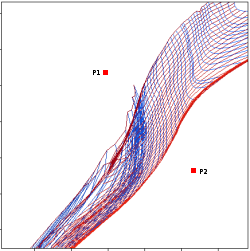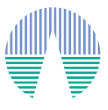HR diagram
[Introduction] [Interpolation] [Flags]
Introduction
The application offers the option to estimate values for the age and the mass of the objects. In order to do that, the (Teff,log(L)) values obtained from the fitting are used as starting points for interpolating collections of theoretical isochrones and evolutionary tracks obtained from the VO. Then, a HR diagram is displayed showing the data points, isochrones and evolutionary tracks.
For each object, only the theoretical isochrones and evolutionary tracks corresponding to the model that best fits the observed photometry are used in the process. In the case where this model is "Kurucz" the NextGen isochrones are used.
When the HR diagram is calculated, and while in the section, the user has a number of options to define the properties of the plot (ranges, which curves must be shown, flip axes...).
Once the user leaves the section, he can recover the last results obtained: interpolated values and the last image generated.
If the user wants to change something again, he has to delete the HR diagram and calculate it again.
Interpolation
(Below, all the explanations are given for the case of obtaining an estimation of the object age interpolating on isochrones. Everything is valid also for the case of obtaining an estimation of the mass interpolating on evolutionary tracks.)
The interpolation between isochrones involves to find the two closer isochrones to the (Teff,log(L)) point (one to each side of the point), calculate the distance from the point to each of the curves and, then evaluate a weighted average between the values of t for each isochrone.
In order to do this it is necessary to design an algorithm able to estimate the distance from a point to a curve defined by discrete points (note that we do not have an analytical curve but just a series of points that are assumed to define a curve).
Distance from a point to a curve
1.-The main method that we use to estimate the distance form the point to an isochrone is as follows:
- First, given the point P (Teff,log(L)) find the closest point in the curve (point P1 at a distance D1)
- Second, find the projection of P to the line defined by P1 and either the next point in the curve or the prior one.
- If either of the projections lies into the interval defined by the two points (P1 and P2), then calculate the distance from the point P to the projection.
- This value will be taken as the distance from P to the isochrone.
2.-In some cases, it is not possible to use the above method because none of the proyections lie inside the interval between the two points that define the line.
When that is the case, we can estimate the distance to the curve as the distance D1 from P to the closest point in the curve P1
Note that we consider this a worse approximation in general. Actually it is highly probable to be bad when P1 is the fist or last point in the curve.
That is why we this method will only be used if the first one fails and if the closest point P1 is not the fist or last point in the curve.
Interpolated value for the age
If we have been able to find a curve on each side of the point P and the distance from that point to each curve, we can using the inverse of the distance as weights:

In some cases, we are able to determine only the distance to one curve, but we know that there exist an isochrone on each side of the point. If that happens we just show a range of values for the age using the ones corresponding to each isochrone as lower and upper limits.
Finally, if the point lies outside the area covered by the isochrones, we do not even try to estimate a value for the age or the mass of the object.

Flags for interpolated values
Whenever we are not able to find a value for the age or the mass of an object or it has been determined using a worse approximation that the one that we consider the best (See above) a flag is shown right to the value.
These are the possible flags and their meanings:
| [1] |
The distance to one of the closer curves has been estimated as the one to the closest point in the curve |
| [2] |
The distance to both the closest curves has been estimated as the one to the closest point in each curve |
| [3] |
Only a range of values can be estimated |
| [4] |
The point lies outside the area covered by the isochrones |
| [5] |
No estimation has been posible |
|


